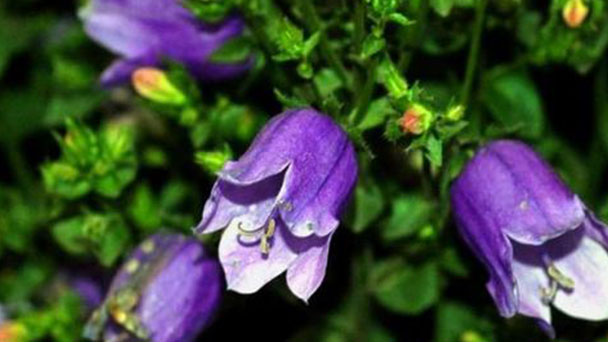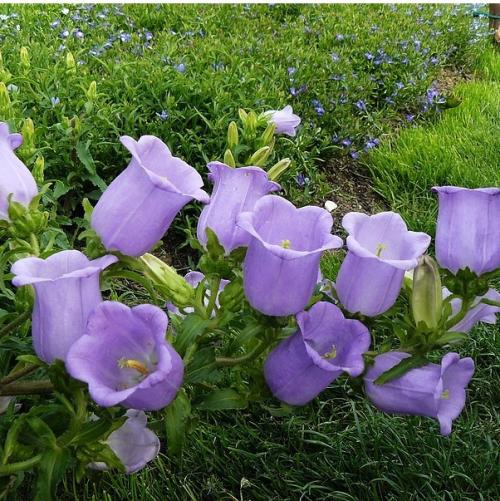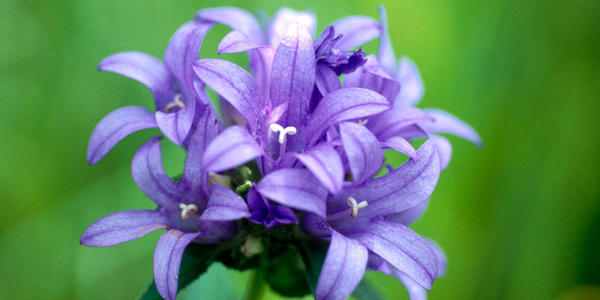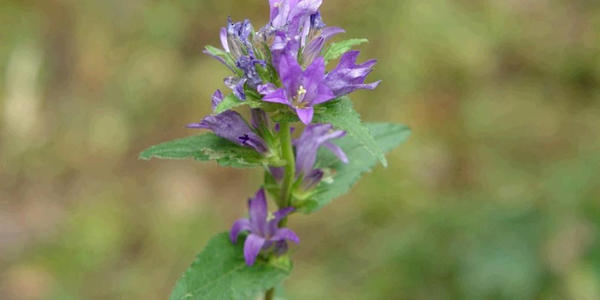Carpathian bellflower (Campanula carpatica) profile
Written by Maggie
Mar 01 2021

Carpathian Bellflower (Campanula carpatica Jacq.), also called Carpathian Harebells, Tussock Bellflower. Plants are 20-40 cm tall. Carpathian bellflower basal leaves are round cordate, upper leaves narrow into oval ovate; Flowers are solitary, with longer pedicels; Calyx lobes are subdued; Corolla is broadly campanulate, white, blue, pink, or purple.
Carpathian bellflower picture

Morphological characteristics of the Carpathian bellflower
Carpathian bellflower is a perennial herb. Root is carrot shaped. Plants are 20-40 cm tall. Basal leaves are cordate, long stalk, upper leaf blade narrower into ovoid, margin sparsely crenate; Distally cauline leaves sessile but more or less operculate, strip lanceolate, entire; Flowers of carpathian bellflower are solitary, with longer pedicels; Calyx lobes are subulate; Corolla if Carpathian bellflower is broadly campanulate, white, blue, pink, or purple.
Ecological habits of the Carpathian bellflower
Carpathian bellflower likes to grow in sunny, well-drained but moist soil environments. Carpathian bellflower has excellent quality of extreme cold resistance and can withstand low temperature of -20 ~ 2°C. The requirement to soil is not strict, it is better to contain rich humus, loose and breathable sandy soil. The pH value of the substrate is between 5.5 and 6.2.
The Carpathian Bellflower's distribution area
Carpathian bellflower distributes in Eastern Europe.
How to grow and care for Carpathian bellflower
Soil
I choose loose, well-draining soil that has the 6-8 pH to grow Carpathian Bellflower.
My bellflowers are often long-living and produce plenty of beautiful flowers for years thanks to the mixture of 50% compost and 50% soil. Keep in mind!
Light
Carpathian Bellflower can still develop in partial shade, but the best condition would be to grow it in a full-sun location. By receiving direct sunlight, your bellflowers will bloom more and more.
Temperature & Humidity
Remember that Carpathian Bellflower cannot grow well if your living area is tropical climates, below 50 degrees at night or regions with hot temperatures. It will only develop in the warm-day-and-cool-night condition.
On top of that, powdery mildew will develop on bellflowers in a humid environment.
Watering
Let the soil completely dry out without being too soggy. Don't water above the flower and leaves. I always water at the soil level and in the early morning. This will keep the moisture away from plant stems or foliage as the soil will dry in the afternoon.
Fertilizer
I apply a balanced way to use fertilizer on Carpathian Bellflower – once in the spring and another in mid-summer. I choose to use organic fertilizer instead of the chemical one. After fertilizing, remember to water plants regularly.

How To Propagate Carpathian Bellflower
Step #1 – Use a power tiller, hoe, or spade to break up the existing soil to the 12-16″ depth.
Make the soil loose and easy-to-work by adding garden compost, manure, or peat moss. Add nutrients and organic ingredients to improve drainage. Don’t eliminate earthworms or useful organisms for the soil.
I even add the all-purpose feed as well as a granulated starter fertilizer to encourage blooming.
Step #2 – To take the Carpathian bellflower out of the container, hold the base, tip it sideways, and then loosen the pot by tapping the outside. Rotate your container and continue tapping until you can remove the plant from there.
Step #3 – Ensure that the dug hole is two times larger in comparison with the root ball (both the depth and width).
Grasp the top of the root ball of the plant. Utilize your fingers to rake the root parts filled your container before putting the plant in the hole.
Step #4 – Use your hands to push and firm the soil surrounding the Carpathian bellflower.
The soil covering the hole must be even or up to one inch compared to the planting ground. Because of new plantings, you need to water daily for several weeks to encourage the growth.
Step #5 – For your bellflowers getting taller, you should support cages or stake at planting time or early in the spring.
Carpathian Bellflower will effectively grow when you give them vertical space. So, providing a wall, trellis, or fence is perfect to let them develop freely.
Step #6 – In this final step, you cover a 2-inch layer of compost or shredded bark, retain the soil moisture, and reduce weeds.
Disease control of Carpathian bellflower
Rust
It mainly harms the leaves, stems and buds of Carpathian bellflower. The leaves showed yellowish green blister water spots, and then gradually expanded, and the blister spots ruptured to reveal the reddish brown summer spore pile, and the leaf tissue around the spots turned pale yellow, and the symptoms at the stem and bud were similar to those at the leaves. The victim plants grow weakly, and in severe cases the leaves are scorched and withered. At the beginning of the disease, 25% powder rust ning 400 ~ 600 times liquid can be used to prevent and control.
Powdery mildew
Fungal disease often damages leaves, but also harms branches, stems, buds and tender shoots, etc. The surface often appears a layer of white powdery mildew layer, later white powdery mildew layer becomes gray, the victim plant short, tender leaves twisted, deformed, withered, leaves do not develop, small, branches deformed, serious plant death. The prevention and control method is combined with pruning, cutting off the sick and residual branches and burning. To strengthen the cultivation management, increase the application of phosphorus and potassium fertilizer and control the application amount of nitrogen fertilizer, improve the plant disease resistance. Selection of disease-resistant varieties, the onset of the early or in the onset of prevention, spraying 50% carbendazim wettable powder 800 ~ 1000 times the liquid, 70% methyl tobutin wettable powder 800 times the liquid, or 25% powder rust would rather wet powder 400 ~ 600 times the liquid, spray once a week, continuous 2 ~ 3 times, alternate use, have special effects on powdery mildew.
Leaf spot
At the initial stage, the leaves of Carpathian bellflower showed water-impregnation necrosis spots, and then quickly changed to dark brown. There were concentric rings with bright and dark phases on the spots, and yellow halo around the spots. Early stage of the disease promptly cut off the disease spots or leaves, and focuses on burning. At the early stage of the disease, spraying 14% luo ammonia copper aqueous solution 350 ~ 500 times, once every 7 ~ 10 days, continuous prevention and treatment for 2 ~ 3 times.
Aphids
Usually concentrated in the tender bud, tender leaves, twigs on the prickle suction juice, causing the plant damaged parts atrophy deformation. Aphids also secrete honeydew to contaminate plants and induce diseases such as soot disease. It can be sprayed with 600 ~ 800 times of wanling, or 800 times of 25% raxis essence emulsion diluted with 25% raxis essence emulsion, or 800 ~ 1000 times of 40% speed emulsion. Quick kill is a broad-spectrum organophosphorus insecticide, which can penetrate into plant tissues with tentacidal, gastric toxicity and strong osmotic effects. It has a good control effect on chewing and stabbing mouth pests. Spray once a week, 2 ~ 3 times in a row, have special effect on scale insects and aphids.
Starscream
Be in leaf back more thorn suction leaf juice, often causing the leaf to change color even curl. It can be used 40% dichromatol mixed with water 1000 times the spray.
Thrips
Feasting on buds, tender leaves, flowers and young fruits on parasitic Carpathian bellflowers of adults or nymphs. The victim Carpathian bellflower grows slowly, young leaf is fed after curl, bud shoot and flower suffer wilting. At the early stage of the disease, it can be prevented and treated with 25% Rhizoma Rhizoma Emulsion or 40% Dithoate 800 ~ 1000 times liquid, or 800 ~ 1000 times liquid of efficient thistle aphidil or thistrialing. Once a week, consecutive 3 ~ 4 times, alternate use, the effect is remarkable.

Latest Updated
- Benefits of Bugleweed - 7 Science-backed Health Benefits
- Bugleweed Dangers & Side Effects - Is It Poisonous?
- How to Plant Evergreen Trees - What You Should Know
- When to Plant Evergreens - Grow Guide for Evergreen Trees
- 12 Wonderful Evergreen Shrubs for Your Garden
- 12 Popular Evergreen Plants with Pictures for Beginners
- When And How To Prune A Lilac Bush Like a Pro
- How to Grow & Care for Lilac Vine (Hardenbergia Violacea)
- Japanese Lilac Tree (Syringa Reticulata) Care & Propagation Guide
- Shumard Oak Pros and Cons - What to Know
Popular Articles
- Winter maintenance of Antirrhinum Majus
- How to Grow Terminalia Mantaly Tree
- How to Grow and Care for Crossostephium Chinense
- How to grow Antirrhinum Majus in spring
- Peristeria Elata (Dove Orchid) Profile: Info & Care Guide
- Underwatered Snake Plant (Sansevieria Trifasciata) - Signs And How To Fix
- How to Care for Brazilian Jasmine Plant (Mandevilla Sanderi)
- How to Grow & Care for Graptopetalum Purple Delight in Summer
- Rosa Chinensis (China Rose): Plant Growing & Care Tips
- How to Care for Baby Sun Rose (Aptenia Cordifolia)